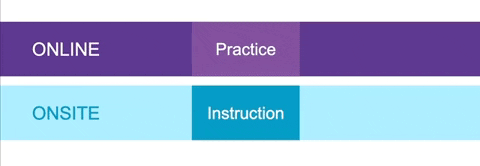One of the changes you’ll find in the 2nd edition of Essentials for Blended Learning is the book is divided into two parts. This is so that those who are unfamiliar with the concept of blending can go deep into examples and concepts in Part 1, while instructors or designers who are already familiar with blending can more easily jump into the action in Part 2, Designing Your Blended Course.
Part 1 provides a background of blended teaching and learning concepts, such as the difference between different types of blended courses. For example, a “flipped” classroom, which moves instruction online to maximize onsite time for hands-on or social practice:

Or a hybrid course, which reduces some amount of traditionally onsite teaching and learning while building connected learning activities online:

A hyflex model is essentially a fully online course and a blended course, giving students the choice between online or onsite learning. Hyflex courses are gaining renewed attention these days in light of campus closures due to COVID-19, as it allows institutions to control the frequency and population of in-class interactions without sacrificing the continuity of teaching, as some students may rotate in or out of onsite sessions/
Part 1 also illustrates examples of blended courses with a variety of activities, focuses on the advantages blending can have in student engagement. Just ahead of Part 2, we introduce our process for blended course design.
Here are the chapters in Part 1:
- Chapter 1 – Blended Teaching and Learning
- Chapter 2 – Examples of Blended Learning
- Chapter 3 – Blending to Maximize Engagement
- Chapter 4 – A Process for Blended Course Design
Check back soon for more excerpts and materials from each chapter!